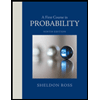Question According tne Ghana Statistical Service data collected in 2020 shows that, 5% of individuals living within the city move to the rural areas during a one-year period, while 4% of individuals living in the rural areas move to the city a one- year period. Assuming that, this process is modeled by a Markov process with two states: city and rural areas a) i. Prepare the matrix of transition probabilities ii. Compute the steady-state probabilities. iii. In a particular District, 40% of the population lives in the city, and 60% of the population lives in the suburbs. What population changes do your steady-state probabilities project for this metropolitan area? "
Question According tne Ghana Statistical Service data collected in 2020 shows that, 5% of individuals living within the city move to the rural areas during a one-year period, while 4% of individuals living in the rural areas move to the city a one- year period. Assuming that, this process is modeled by a Markov process with two states: city and rural areas a) i. Prepare the matrix of transition probabilities ii. Compute the steady-state probabilities. iii. In a particular District, 40% of the population lives in the city, and 60% of the population lives in the suburbs. What population changes do your steady-state probabilities project for this metropolitan area? "
A First Course in Probability (10th Edition)
10th Edition
ISBN:9780134753119
Author:Sheldon Ross
Publisher:Sheldon Ross
Chapter1: Combinatorial Analysis
Section: Chapter Questions
Problem 1.1P: a. How many different 7-place license plates are possible if the first 2 places are for letters and...
Related questions
Topic Video
Question
Q5

Transcribed Image Text:Question
According tne Ghana Statistical Service data collected in 2020 shows that, 5%
of individuals living within the city move to the rural areas during a one-year
period, while 4% of individuals living in the rural areas move to the city a one-
year period. Assuming that, this process is modeled by a Markov process with
two states: city and rural areas
a) i. Prepare the matrix of transition probabilities
ii. Compute the steady-state probabilities.
iii. Ina particular District, 40% of the population lives in the city, and 60% of
the population lives in the suburbs. What population changes do your
steady-state probabilities project for this metropolitan area? '
Expert Solution
This question has been solved!
Explore an expertly crafted, step-by-step solution for a thorough understanding of key concepts.
This is a popular solution!
Trending now
This is a popular solution!
Step by step
Solved in 2 steps with 1 images

Knowledge Booster
Learn more about
Need a deep-dive on the concept behind this application? Look no further. Learn more about this topic, probability and related others by exploring similar questions and additional content below.Recommended textbooks for you

A First Course in Probability (10th Edition)
Probability
ISBN:
9780134753119
Author:
Sheldon Ross
Publisher:
PEARSON


A First Course in Probability (10th Edition)
Probability
ISBN:
9780134753119
Author:
Sheldon Ross
Publisher:
PEARSON
